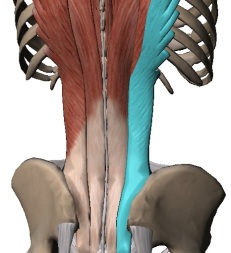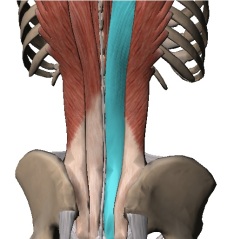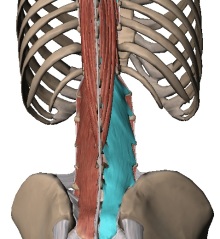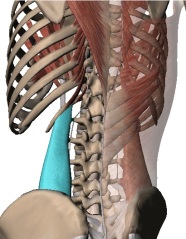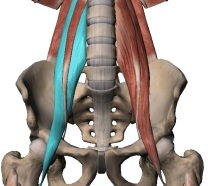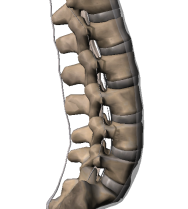
The bodies of the lumbar vertebrae are large and transverse oval-shaped. The big vertebral arches and spinous process are positioned in such a way that the vertebral foramen has a triangular shape. The transverse processes in the lumbar vertebrae are larger than in the cervical and thoracic spine. They are rudimental costal elements; for this reason they are called Processus costales. The Processus articulares superior is slightly concave and faces medially, while the Processus articulares inferior is convex and faces laterally. They are both orientated vertically (Schuenke et al, 2006).
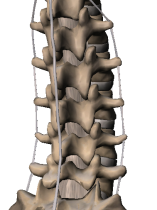 The most important ligaments in the lumbar spine are the anterior and posterior longitudinal ligaments, they run on the anterior and posterior side of the vertebral bodies. The anterior ligament goes from the base of the skull till the os sacrum, and is firmly attached to the vertebral bones while being quite loose on the intervertebral discs. The posterior ligament passes into the sacral canal and broadens at the level of the intervertebral discs. Thus, the fact that the intervertebral disc does not have ligamentous reinforcement, especially on the lateral side, is promoting disc herniation probability. The ligamentum flavum is a thick, yellow and powerful ligament connecting the vertebral arches. It limits forward flexion and it helps the back muscle to stabilize the spinal column in the erect position. The ligamenti supraspinous and infraspinous are running at the spinous processes and the intertransverse ligaments which connects the transverse processes, and limits the two vertebras from touching each other (Schuenke et al, 2006). Another important ligament, that is not present at any other level of the vertebral column, is the iliolumbar ligament that stabilizes the fifth lumbar vertebra and the ilium (Magee, 2006).
The most important ligaments in the lumbar spine are the anterior and posterior longitudinal ligaments, they run on the anterior and posterior side of the vertebral bodies. The anterior ligament goes from the base of the skull till the os sacrum, and is firmly attached to the vertebral bones while being quite loose on the intervertebral discs. The posterior ligament passes into the sacral canal and broadens at the level of the intervertebral discs. Thus, the fact that the intervertebral disc does not have ligamentous reinforcement, especially on the lateral side, is promoting disc herniation probability. The ligamentum flavum is a thick, yellow and powerful ligament connecting the vertebral arches. It limits forward flexion and it helps the back muscle to stabilize the spinal column in the erect position. The ligamenti supraspinous and infraspinous are running at the spinous processes and the intertransverse ligaments which connects the transverse processes, and limits the two vertebras from touching each other (Schuenke et al, 2006). Another important ligament, that is not present at any other level of the vertebral column, is the iliolumbar ligament that stabilizes the fifth lumbar vertebra and the ilium (Magee, 2006).
The main muscle acting over the lumbar spine is the erector spinae, that can be divided in many other muscles. The muscles in the lumbar spine are: Iliocostalis lumborum, longissimus thoracis, intertransversarii laterales lumborum, intertransversarii mediales lumborum, interspinales lumborum, spinalis thoracis, multifidus also commonly called, for simplicity’s sake, intrinsic back muscles (see table for details on origin, insertion and action). The muscle quadratus lumborum, psoas major and diaphragma are also connected to the lumbar spine (Schuenke et al, 2006).
Muscle: Iliocostalis Lumborum
Origin:
- Os sacrum
- Crista iliaca
- Fascia thoracolumbalis
Insertion:
- 6th-12th ribs
- Deep layer fascia thoracolumbalis
- Transverse processes of upper lumbar vertebrae
Function:
- Bilateral: Extension of the spine
- Unilateral: Ipsilateral lateral flexion
Muscle: Longissimus Thoracis
Origin:
- Os sacrum
- Crista iliaca
- Fascia thoracolumbalis
Insertion:
- 2nd-12th ribs
- Costal processes of lumbar vertebrae
- Transverse processes of thoracic vertebrae
Function:
- Bilateral: Extension of the spine
- Unilateral: Ipsilateral lateral flexion
Muscle: Intertransversarii Laterales Lumborum
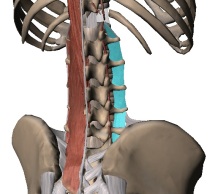
Origin: Course between adjacent processuss costales of all lumbar vertebrae
Insertion: Course between adjacent processuss costales of all lumbar vertebrae
Function:
- Bilateral: Extension of the spine
- Unilateral: Ipsilateral lateral flexion
Muscle: Intertransversarii Mediales Lumborum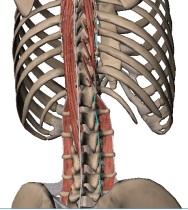
Origin: Course between adjacent processuss mamillares of all lumbar vertebrae
Insertion: Course between adjacent processuss mamillares of all lumbar vertebrae
Function:
- Bilateral: Stabilization and extension of the lumbar spine
- Unilateral: Ipsilateral lateral flexion
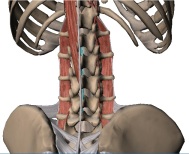
Muscle: Interspinales Lumborum
Origin: Course between adjacent processuss spinosus of all lumbar vertebrae
Insertion: Course between adjacent processuss spinosus of all lumbar vertebrae
Function: Extension of the lumbar spine
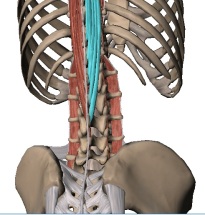
Muscle: Spinalis Thoracis
Origin: Lateral surface of the spinous processes of the T10-T12 and L1-L3
Insertion: Lateral surface of the spinous processes of the T2-T8
Function:
- Bilateral: Extension of the thoracic spine
- Unilateral: Ipsilateral lateral flexion of the thoracic spine
Origin: Course between the transverse processes and spinous processes of the whole spine
Insertion: Course between the transverse processes and spinous processes of the whole spine
Function:
- Bilateral: Extension of the spine
- Unilateral: Ipsilateral lateral flexion and contralateral rotation
Origin: Crista iliaca
Insertion:
- 12th rib
- Costal processes of L1-L4
Function:
- Bilateral: Bear down and expiration
- Unilateral: Ipsilateral lateral flexion
Muscle: Psoas Major
- Processus costarii of the L1-L5 vertebrae
- Lateral surfaces of the vertebral bodies and intervertebral disc of the T2, L1-L5 vertebrae
Insertion: Insert together with M. Iliopsoas on the minor trochanter of the femur
Function:
- Bilateral: Raise the trunk from supine
- Unilateral: Lateral flexion of the lumbar spine, flexion and external rotation of the leg
The following pictures are published with permission of visible body (Argosy Publishing). ESP students can enter via the HvA library, which enables them to enter the body views for free.
Movements at the lumbar spine
Flexion: 50° out of 150° of the whole spine
Extension: 35° out of 100° of the whole spine
Resting Position “0”: Midway between flexion and extension
Close packed position: Extension
Capsular pattern: Lateral flexion and rotation equally limited, extension
